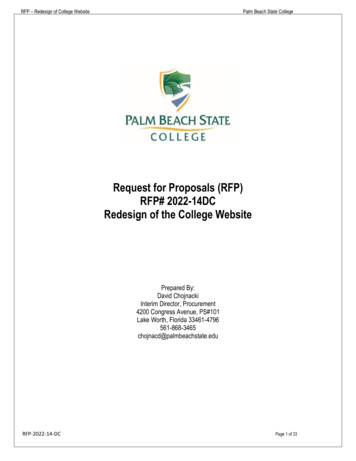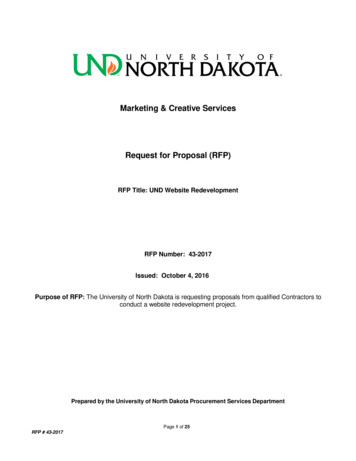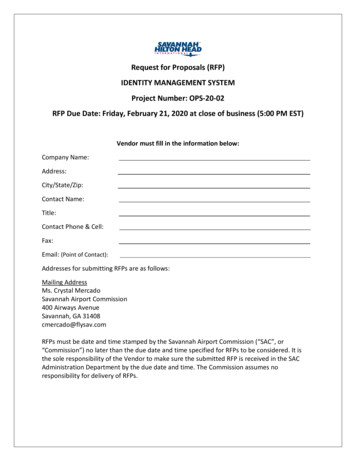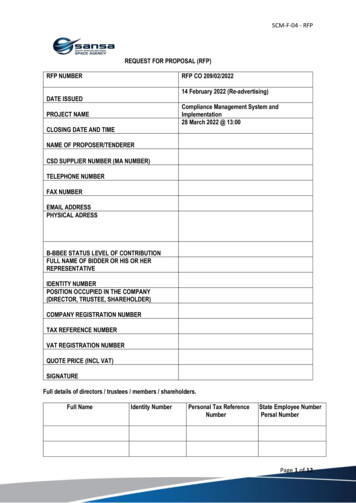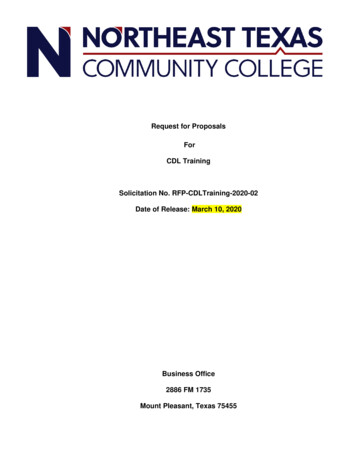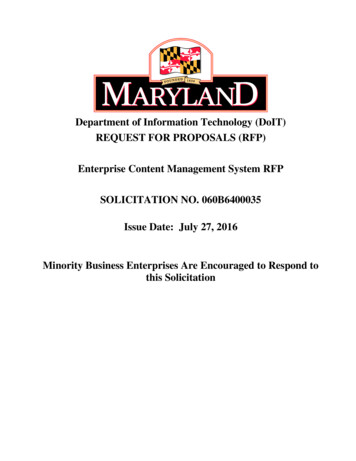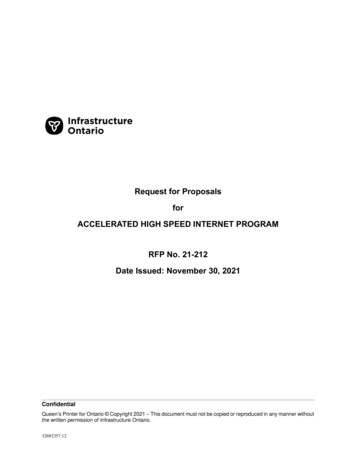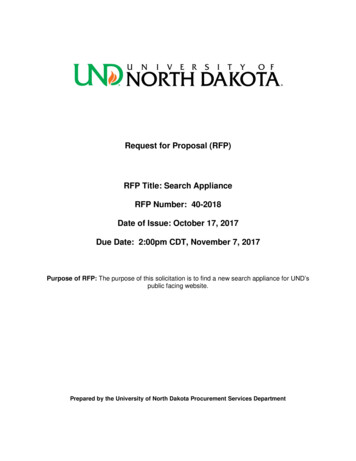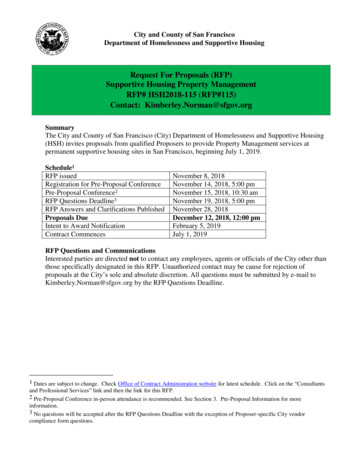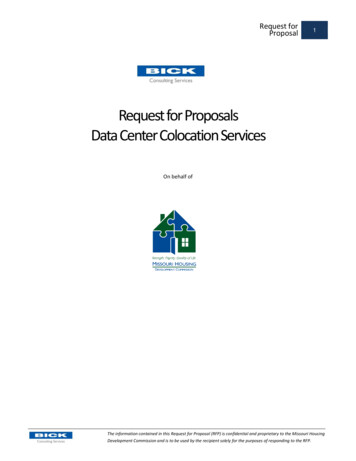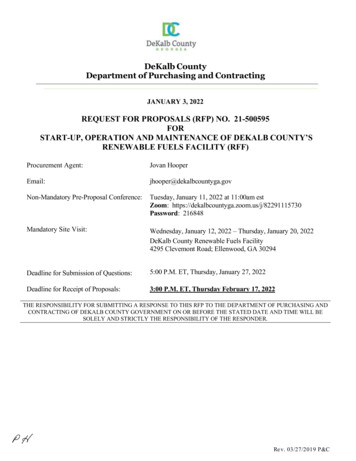
Transcription
DeKalb CountyDepartment of Purchasing and ContractingJANUARY 3, 2022REQUEST FOR PROPOSALS (RFP) NO. 21-500595FORSTART-UP, OPERATION AND MAINTENANCE OF DEKALB COUNTY’SRENEWABLE FUELS FACILITY (RFF)Procurement Agent:Jovan y Pre-Proposal Conference:Tuesday, January 11, 2022 at 11:00am estZoom: rd: 216848Mandatory Site Visit:Wednesday, January 12, 2022 – Thursday, January 20, 2022DeKalb County Renewable Fuels Facility4295 Clevemont Road; Ellenwood, GA 30294Deadline for Submission of Questions:5:00 P.M. ET, Thursday, January 27, 2022Deadline for Receipt of Proposals:3:00 P.M. ET, Thursday February 17, 2022THE RESPONSIBILITY FOR SUBMITTING A RESPONSE TO THIS RFP TO THE DEPARTMENT OF PURCHASING ANDCONTRACTING OF DEKALB COUNTY GOVERNMENT ON OR BEFORE THE STATED DATE AND TIME WILL BESOLELY AND STRICTLY THE RESPONSIBILITY OF THE RESPONDER.Re v. 03/27/2019 P&C
TABLE OF duction .3Scope of Work & Project Compensation .7Scope of Work Attachments .12Proposal Format .13A. Revenue Proposal .13B. Technical Proposal .13C. Federal Work Authorization Program .15Criteria for Evaluation .15Contract Administration.15A. Standard County Contract .15B. Submittal Instructions .15C. Non-Mandatory Pre-Proposal Conference .16D. Mandatory Acknowledgement of Site Visit.16E. Questions .16F. Acknowledgement of Addenda .16G. Proposal Duration .17H. Project Director/Contract Manager .17I. Expenses of Preparing Responses to this RFP .17J. Georgia Open Records Act.17K. First Source Jobs Ordinance .17L. Business License .18Award of Contract.19Attachment A. Revenue Proposal .21Attachment B. Proposal Cover Sheet.22Attachment C. Contractor Reference and Release Form .23Attachment D. Subcontractor Reference and Release Form .24Attachment E. Sample County Contract .25Attachment F. Responder Affidavit .41Attachment G. First Source Jobs Ordinance Information .42Attachment H. Mandatory Acknowledgement of Site Visit .55Attachment I. Exceptions to the Sample County Contract (if any) .56Page 2 of 56Revised 11/09/2020 P&C
DeKalb CountyDepartment of Purchasing and ContractingMaloof Administration Building, 1300 Commerce Drive, 2nd Floor, Decatur, Georgia 30030JANUARY 3, 2022REQUEST FOR PROPOSALS (RFP) NO. 21-500595FORSTART-UP, OPERATION AND MAINTENANCE OF DEKALB COUNTY’S RENEWABLE FUELSFACILITY (RFF)DEKALB COUNTY, GEORGIADeKalb County Government (the County) requests qualified individuals and firms with experience withoperation of renewable natural gas utilities or conversion facilities employing LFG as the feedstock, with acapacity of at least 1,000 scfm to submit proposals for the start-up, operation and maintenance of the County’srenewable fuels facility (RFF).I.INTRODUCTIONA. BackgroundDeKalb County (County) owns and operates the Seminole Road Landfill (SRLF) located at 4203Clevemont Road, Ellenwood, GA 30294. The County owns two landfill gas (LFG) utilizationfacilities which are located at SRLF – the Renewable Fuels Facility (RFF) and the Green EnergyFacility (GEF). The SRLF currently has two landfill gas blower/flare skids: (i) a LFG Specialtiescandlestick flare with blowers, and (ii) an Ultra-Low NOx Emissions enclosed flare with blowers. Thecandlestick blower/flare skid is currently operational and collects and destructs any excess LFG thatis not utilized by the GEF. The Ultra-Low NOx blower and flare skid is not currently operational butis currently being evaluated for re-start or will be replaced with a second candlestick flare. Both flaresare and will be connected to provide combined back-up capacity to destruct any excess LFG or wastegas from the RFF.The total LFG collected at SRLF is currently in the range of 1,800 – 2,200 scfm. The County is in theprocess of expanding the gas collection and control system (GCCS) at SRLF in 2021 which is expectedto increase the LFG collection flow rate. SRLF has approximately 75 years of permitted site liferemaining and will continue to expand the landfill GCCS in order to comply with the New SourcePerformance Standards (NSPS) and Title V permit requirements.The County currently has an agreement with Conyers Energy who has first rights to the LFG collectedand in order to operate the existing two engines capable for utilizing 1,200 standard cubic feet perminute (scfm) of LFG, and a permitted third engine that may be installed in the future that could utilizean additional 600 scfm of LFG. The remaining excess gas is currently flared at the candlestick flare.Page 3 of 56Revised 11/09/2020 P&C
B. Purpose of RFPThe County’s best use for its LFG is the production of electricity at the GEF and RNG at the RFF.Therefore, the County wishes to enter into a contract with a qualified firm or team to restart operationsof the RFF and utilize the remaining LFG collected after utilization by the GEF to produce RNG thatwill be used as vehicle transport fuel.The proposers will be expected to evaluate the current equipment at the RFF, perform the necessarychanges to bring the facility to operational condition, and operate and maintain the RFF to utilize theremaining LFG to produce RNG for injection into the pipeline or use at the CNG fueling station. Forthe purposes of this RFP, the scope of work requested by the County includes, but is not limited to,planning, permitting, financing, design, construction, operation, maintenance, and environmentalmonitoring services for re-starting the existing RFF or modifying it to produce RNG. In addition, thescope of work includes marketing, sale and distribution of the full market value of the LFG and RNG,including all forms of energy and environmental attributes / renewable index credits, and taxincentives.The RFF is currently mothballed and has not been operational since 2017. The current RFF employspressure swing adsorption (PSA) technology to convert LFG into a natural gas quality equivalent,known as renewable natural gas (RNG). Piping connections exist to inject the RNG produced into thenatural gas utility, Atlanta Gas Light’s (AGL) pipeline, which is adjacent to the RFF. RNG can alsobe utilized to produce CNG vehicle fuel to be dispensed at the adjacent County-owned CNG fuelingstation. The RFF commenced operation in January 2013 and has operated intermittently since thattime until 2017. The maximum inlet capacity of the RFF is approximately 1,300 scfm, under certainconditions.The Proposers shall note the following while proposing to perform this work: All capital money to restart, operate and maintain the DeKalb County Renewable Fuels Facilitymust come from the Contractor, there will be no cost to the County.The County will be responsible for the permitting, design, construction, operation, andfinancing of the landfill Gas Collection and Control System (GCCS);The County will be responsible for operation and maintenance of the landfill GCCS andintends do so in a manner that prioritizes environmental and regulatory compliance and odormitigation;The County does not exert control of the composition or quantities of waste that are deliveredto the Seminole Road Landfill and, thus, cannot warranty or guarantee the quantity or qualityof the LFG recovered.C. Existing RFF Related InformationThe information in this section is provided to the Proposer to assist with their evaluation of the existingRFF and the provision of this information provides no substitute for the requirement for the Proposerto perform their own evaluation. The County does not provide any guarantees for the accuracy of thisinformation and the Proposer will be fully responsible to confirm and perform their own evaluation ofthe existing RFF.The existing RFF consists of equipment to convert LFG to RNG through the following principal stepsPage 4 of 56Revised 11/09/2020 P&C
(as provided by the original design-build contractor / manufacturer of the system): Hydrogen Sulfide (H2S) Removal – A microorganism-based, aqueous scrubber system.Blowdown from the system is discharged to the sanitary sewer. Bacteria and enzyme isintermittently pumped into the system from storage drums. Proprietary bacteria and enzymesolutions supplied by ARC Technologies (ARC);LFG Blowers – Two rotary positive displacement blowers. One 50 horsepower (hp) blowerprovides a constant vacuum on the wellfield, tracking a County set point, and also provides aninitial positive pressure to downstream processes. The second 25 hp blower returns recycledgas from the recycle tank to the front of the plant;LFG Cooling and Chilling – Water-to-LFG heat exchanger and chilled water-to-LFG heatexchanger;Volatile Organic Compound (VOC) Removal [Step 1] – VOCs are initially removed in aliquid scrubber system. The scrubber liquid is a cold hydrocarbon. A blowdown stream isregenerated by heating the cold hydrocarbon to drive off the captured VOCs. An electric heateris employed. The vaporized VOCs are then cooled and condensed. The condensed VOCs aresent to a 500-gallon waste VOC storage tank. The regenerated hydrocarbon is cooled andreturned to the scrubber;LFG Compression – LFG is compressed to about 100 psig using flooded screw compressors.It was intended that one compressor be online and one compressor be a standby at 1,000 scfm.At 1,300 scfm, both compressors would probably need to be placed in service. Aftercompression, LFG is cooled in a water-to-LFG cooler;VOC Removal [Step 2] – A temperature swing adsorption (TSA) system is used to achievefurther VOC removal. The TSA provides final protection for the downstream Pressure SwingAdsorption (PSA) system. The TSA has two stages – a desiccant first step (primarily to removemoisture) and an activated carbon step (for final VOC and H2S removal). The TSAregenerates once per week. Regeneration is accomplished by backflow of hot product gasthrough the vessels. The gas is cooled after leaving the vessels. VOCs condense out of thecooled gas. The gas is then reheated, with an electric heater, for recirculation through thevessels. The condensed VOCs are sent to the 500-gallon waste VOC storage tank. Becausethe TSA incorporates three 50 percent capacity trains, regeneration occurs without a reductionin facility capacity. To improve the effectiveness of the desiccant step (the desiccant media isof limited volume), the desiccant is regenerated every 90 minutes by pressure swing, using theprimary PSA’s vacuum blowers;Pressure Swing Adsorption (PSA) – The PSA removes carbon dioxide (CO2), and limitedamounts of nitrogen (N2) and oxygen (O2). The PSA at the RFF is proprietary to ARC, butfollows the general principles of an LFG PSA. It incorporates a seven-vessel configuration,equalization tanks (recycle gas, product gas and waste gas) and three vacuum blowers;Waste Gas Flare – The RFF does not have its own waste gas flare. Waste gas is sent back tothe County’s remotely located blower/flare yard. The waste gas was originally sent to theCounty’s candle-stick flare, which required a minimum CH4 content of about 30 percent. TheCounty has also installed and commissioned an ultra-low NOx flare (not currently operational).The waste gas line from the RFF has been piped to the flares, as the points of waste gasdisposal. The RFF has the ability to blend natural gas into the waste gas to increase its CH4content, and such augmentation may be necessary by the RFF Operator to support reliablePage 5 of 56Revised 11/09/2020 P&C
combustion of the waste gas in the flares. The Proposer will be responsible for coordinatingthe operation of the RFF and the flares and to limit the use of natural gas;Product Gas Compressor – A reciprocating compressor compresses RNG up to AGL’spipeline pressure (as high as 500 psig, with normal operation at 200 to 250 psig);Product Gas Odorizer – Provides injection of an odorant into the RNG to give the RNG thetraditional natural gas odor; andSCADA – Plant wide computer control system with internet access.Additional descriptive information on the RFF can be found in Appendix A (Process andInstrumentation Diagrams) and Appendix B (DeKalb County – Seminole Road Landfill LFG to CNGProject Operations & Maintenance Manual 04/20/13). The document in Appendix A is intended to berepresentative of the existing facility, but may not be 100 percent up-to-date. The RFF Safety Programdocument developed by the conversion system manufacturer (ARC) is provided in Appendix C. Theexisting RFF Startup, Shutdown and Malfunction (SSM) Plan that details the procedures and formspreviously used in SSM reporting for the RFF are contained in Appendix D. The procedures andforms to be used during previous operations are shown in the RFF Monitoring Plan presented asAppendix E.The following consumables items are utilized by the existing RFF in their original design andoperation condition: Enzyme and Bacteria – Estimated to be 110 gallons (each substance) per year when operatingat 1,000 scfm at 95 percent uptime. The enzymes and bacteria are proprietary from the originalsystem manufacturer (ARC;Waste VOC Removal – Estimated to be about 10,000 gallons per year when operating at1,000 scfm at 95 percent uptime (expected to be disposed of as a waste oil);TSA Media Replacement – The TSA contains about 300 ft3 of activated carbon and about120 ft3 of silica gel. The frequency of media replacement is unknown. It can be assumed thatthe TSA media must be changed once every 18 months, when operating at 1,000 scfm at 95percent uptime; andPSA Media ReplacementPage 6 of 56Revised 11/09/2020 P&C
D. The following Required Documents Checklist includes a list of attachments which must be completedand returned with Responder’s technical proposal:Required DocumentsAttachmentRevenue Proposal FormA(1 copy, separate & sealed)Proposal Cover SheetBContractor Reference and Release FormCSubcontractor Reference and Release FormD(make additional copies as needed)Responder AffidavitFFirst Source Jobs OrdinanceGMandatory Acknowledgement of Site VisitHExceptions to the Standard County Contract,Iif anyE. The services shall commence within ten (10) calendar days after acknowledgment of receipt of writtennotice to proceed and shall be completed within a minimum of two thousand, five hundred and fiftyfive (2,555) days.F. The County reserves the right to make one (1) award or multiple awards.II.SCOPE OF WORK & PROJECT COMPENSATIONThe County wishes to engage a firm to perform the necessary evaluations, upgrades / repairs or install newequipment to bring the RFF back to operating condition and operate/maintain the RFF for a period of seven (7)years minimum.The Proposer will be responsible to perform their own evaluation in order to assess the condition of the existingRFF equipment, and will be required to provide the capital to perform the necessary steps and upgrades torestart the RFF. DeKalb County has no funds allocated to the evaluation, startup, and operation andmaintenance of this facility.The Proposer will be given the opportunity to visit the current RFF to perform their evaluations necessary forthem to submit a proposal. The interested firms can coordinate with County staff to schedule time to visit theRFF and perform their evaluations. The County will allow up to seven (7) days to perform the evaluation.The Proposer will be required to provide a detailed proposal providing the specific steps that will be taken,and upgrades that will be made to the RFF equipment. The proposer shall detail the process that will beutilized for production of RNG, i.e., if the proposer intends to utilize current RFF equipment or replaceequipment to utilize a different or modified process. The proposal shall also consist of a detailed schedulewith milestones for the RFF restart. The proposer shall also present the financial mechanism they propose forthis work.A. Production of RNG from LFGThe Proposer must perform all necessary activities such as, but not limited to, planning, permitting, financing,design, construction, operation, maintenance, and environmental monitoring services for the RFF to producePage 7 of 56Revised 11/09/2020 P&C
on-specification RNG. On-specification RNG shall be produced per the requirements and specifications of thenatural gas utility, AGL. Per AGL’s requirements on-specification pipeline quality natural gas shall be: be free of objectionable elements or compounds that will render the gas unusable for its commonly usedapplications;be commercially free from dust, gums, gum-forming constituents, or other liquid or solid matter whichmight become separated from the gas in the course of transportation through the pipeline or which couldcause inaccurate measurement;not contain more than 12 PPM of total sulfur (prior to odorizing) or 4 PPM of hydrogen sulfide;not contain more than 3 percent by volume of carbon dioxide or nitrogen;not contain more than 1 percent by volume of oxygen;not contain more than 4 percent total inerts;not contain more than 7 pounds of water per 1,000 MCF;have a temperature of not more than 120 degree Fahrenheit, nor less than 40 degrees Fahrenheit;have a Wobbe Index range between 1,234 and 1,395;have a gross heating value of at least 950 Btu per cubic foot of dry gas but no higher than 1,045 Btu percubic foot of dry gas. The gross heating value of the gas shall be determined by a mutually acceptabletest of one cubic foot of gas at a temperature of 60 degrees Fahrenheit and at a pressure of 14.73 poundsper square inch absolute. Tests to determine the heating value will be conducted at time intervalsdetermined by AGL. The point of test shall be as close as practical to the point of custody transferbetween supplier and AGL; andbe free of the level of microbial constituents that contribute to microbial-induced corrosion.The Proposer shall verify these requirements with AGL and produce RNG that meets the required specification.In addition to the above, the County expects that the Proposer will:1. Have operations staff present at the facilities, or when not present (e.g., overnight), to respond to facilityshutdowns with staff presence at the site within four hours of a shutdown (unless the shutdown is due toan LFG supply issue confirmed remotely by the Proposer);2. Maintain all equipment per equipment manufacturer’s recommendations and procedures and the facilityoperation/maintenance manuals;3. Maintain and operate the facilities per the facility operation and maintenance manuals and per anindustry standard level of quality and performance;4. Maintain a full inventory of spare parts; and5. Employ experienced and skilled operation and maintenance staff and experienced and skilledsubcontractors.6. Comply with all inspections, reporting, and applicable permit conditions.Natural Gas Utility’s RNG Delivery and Posting Expectations – Anticipated RNG delivery expectationsmust be posted to a web-based electronic bulletin board (EBB) created by and be maintained by the Proposerto the natural gas utility (AGL) specifications and meeting AGL’s notification timelines. It is the Proposer’sresponsibility to perform and maintain projections of RNG delivery according to AGL’s timeline requirementsPage 8 of 56Revised 11/09/2020 P&C
each month. It is also understood that AGL will designate a certain number of supply days and demand dayseach year. The RFF will not be permitted to supply more than the projected delivery amount on supply days,or less than the projected delivery amount on demand days, without payment of a penalty. There is also apenalty for not zeroing out deliveries by the end of the month. The Proposer will be responsible for all payments,penalties and other requirements by AGL.The County’s existing contract with AGL for transportation of natural gas using the pipeline is provided inAppendix F.B. Renewable Fuel Credits Management and MarketingBecause biogas from the landfill intended to be used ultimately as a transportation fuel as a result of this project,the RNG produced from the RFF is eligible to potentially earn renewable fuel credits or RenewableIdentification Numbers (RINs) under the federal Renewable Fuel Standard (RFS2) as well as credits in emergingregional / state programs for Clean Fuel Standards. The RINs can be purchased by obligated parties (refiners,fuel importers).As part of the scope of this RFP, Proposers shall perform all steps required to successfully create and manageRINs and generate revenue from the sale of the RINs. The process to generate RINs requires a significantregistration and auditing process that includes, but is not limited to, the following: 1. 2. Facility Registration (3rd party engineering review)High Btu Facility Registration and AttestationsAnnual and quarterly reportsAnnual audits by third party verifiers for all RIN transactionsFacility RegistrationRegister landfill with US Environmental Protection Agency (EPA)Prepare documents for third party engineering review (process flow diagrams of site, feedstockdescription, andEngage qualified third-party engineer to undertake review and submit report to EPA (the report must besubmitted at least 60 days prior to RIN creation)Establish monitoring system for transport fuel generation and consumption at landfillRIN Creation and ManagementManage storage logistics to ensure RIN generationSubmit quarterly reports to EPA documenting the generation and consumption of biogas as atransportation fuelSubmit annual report to EPAManage all RIN transactions (on-site) and potential off-site, subject to EPA implementation timeline,and open pathwayMake submissions to EPA RFS Program Director for off-site downstream pathways to open off siteCNG for RIN creationPage 9 of 56Revised 11/09/2020 P&C
3.Credit Marketing EM has strong relationships with major compliance buyers, having already been approved as a seller ofRINSEM will make also make biogas in alternative markets where facility's biogas used as a transport fuelmay be eligibleMonitor market and regulatory risks impacting RIN MarketsCooperate and receive cooperation from DeKalb County gas manager / purchaser and facility managerfor data, contracts (title transfer) and reconciliationC. Proposer’s Reporting and Other RequirementsThe Proposer must provide certain data and reports to allow the County to satisfy its regulatory obligations, andto recover revenue from the production of RNG. All data and reports related to the satisfaction of the County’sregulatory obligations will be conveyed to regulators through the County.The Proposer is responsible for the following activities:1. RFF Startup, Shutdown and Malfunction (SSM) Reporting – The Proposer shall be responsible forpreparing a SSM Plan for the RFF which details the procedures and forms to be used in SSM reporting.This plan shall be provided to the and the County’s compliance Consultant for review and approval.SSM reports shall be submitted to the County and the County’s compliance Consultant on a weeklybasis at minimum.2. Renewable Identification Number (RIN) Reporting – Monthly RNG delivery to the pipeline must becertified in a format required by the County’s RIN marketer.3. Title V permit and Relevant Reporting – A copy of the County’s current Title V permit (dated July31, 2018), and Permit Amendment dated May 8, 2019, are attached in Appendix G. The Title V permitand this letter call for recording and retention of certain data and adherence to certain procedures. TheProposer must take note of and follow these directives.4. Monitoring Plan Reporting – The Proposer shall be responsible for preparing a Monitoring Plan forthe RFF to which identifies the treatment system equipment and establishes the monitoring parametersand frequency to confirm proper operation and maintenance of the system. This plan shall be providedto the and the County’s compliance Consultant for review and approval. Monitoring reports shall besubmitted to the County and the County’s compliance Consultant on a monthly basis at minimum.5. RFF Daily and Monthly Operation Reporting – The Proposer shall prepare and provide daily andmonthly-summary operation reports for the RFF, reporting routine activities such as but not limited toquantity and quality of inlet LFG received, quantity and quality of RNG produced, operating times,RNG recovery efficiency, and maintenance activities.6. Greenhouse Gas (GHG) Rule Reporting – The Proposer shall provide all information required tocomply with the GHG rule reporting requirements to the County’s compliance Consultant.7. Safety Program – The Proposer shall prepare a safety plan for the RFF and submit to the County.8. The County considers the RFF to not only be an energy production facility, but also to be an educationalcenter. The Contractor must keep the facility clean and “tour ready” at all times. The current facilityhas meeting areas and viewing areas equipped with interactive display screens, which display facilityoperation. The screens must be maintained and available for use at all times to support facility tours.The Proposer must be prepared to accept reasonable changes and additions to the above requirements duringPage 10 of 56Revised 11/09/2020 P&C
the life of the contract.D. Proposer’s Minimum Landfill Gas Renewable Energy ExperienceThe Proposer must demonstrate the following:1. Adequate experience with operation of renewable natural gas utilities or conversion facilities employingLFG as the feedstock, with a capacity of at least 1,000 scfm.2. The Proposer will provide documentation such as project descriptions, project cost, references etc. withthe proposal which confirms that the Proposer has the adequate experience to operate the facility.3. Present evidence that the Proposer or its team has been engaged for at least the past five (5) years inproviding services related to environmental commodities.4. The Proposer will provide references and contact information which will facilitate the County’sindependent verification of the Proposer’s cited experience.E. Project Compensation MechanismThe Proposer is solely responsible for all financing related to the planning, permitting, design, construction,operations, maintenance, repair, replacement, rehabilitation and environmental compliance monitoring andreporting associated with the modification and restart of the RFF. The Proposer shall present the financialrevenue-sharing arrangement they propose to compensate the County for the following at minimum: 1) the rawLFG utilized by the RFF at the agreed upon point of delivery, 2) sale of RNG produced from utilizing the LFG,3) sale of environmental attributes such as RINs. The County desires to receive such compensation on amandated monthly basis.F. Proposal SubmittalProposals must provide the following at minimum related to the scope, qualifications, and compensation, inaddition to all other required forms and documents identified elsewhere in the RFP:1. a Project Description and Approach that describes the specific steps that will be taken, and upgrades /modifications that will be made to the RFF equipment to produce RNG from LFG. The proposer shalldetail the process that will be utilized for production of RNG, i.e., if the proposer intends to utilizecurrent RFF equipment or replace equipment to utilize a different or modified process.2. details of the scope
DeKalb County (County) owns and operates the Seminole Road Landfill (SRLF) located at 4203 Clevemont Road, Ellenwood, GA 30294. The County owns two landfill gas (LFG) utilization facilities which are located at SRLF the Renewable Fuels Facility (RFF) an- d the Green Energy Facility (GEF).
